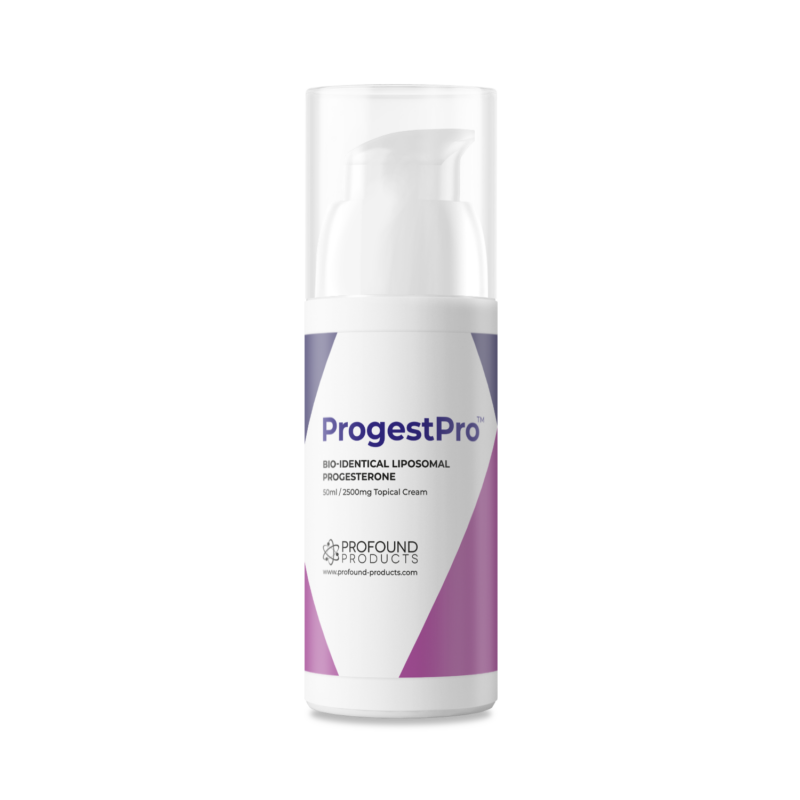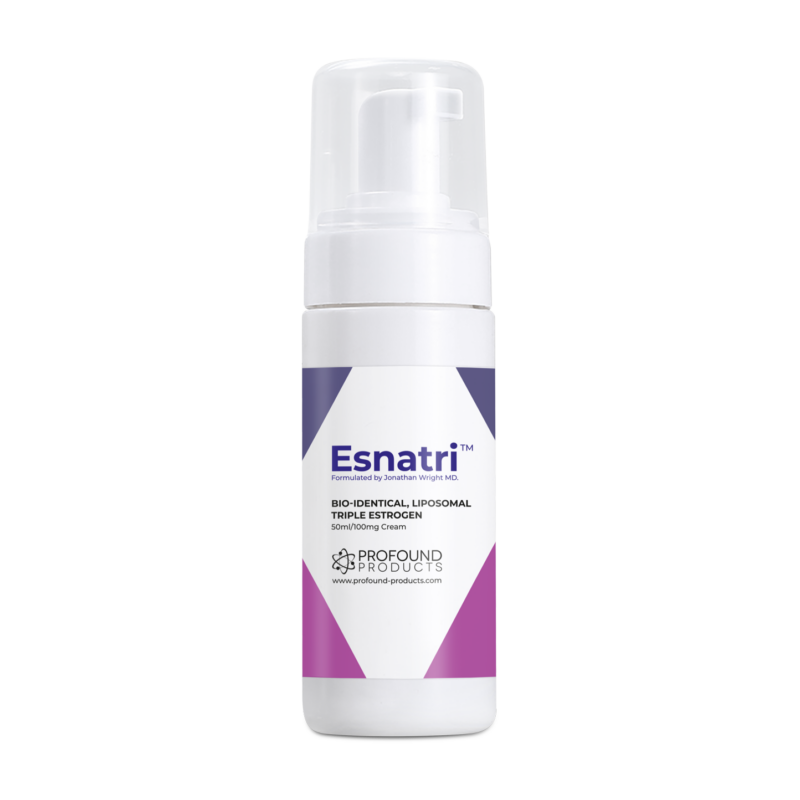Natural Triple Estrogen and Progesterone for Women
“To stay healthy, observe and follow nature.” Physicians and master healers have made this statement for literally thousands of years, in many languages and variations. It remains true today. For this reason, some question the basic concept of hormone replacement therapy during or after menopause, rightly pointing out that hormones naturally decline with age, relatively abruptly at menopause for women, more gradually for men. So how can it be “natural” to replace hormones at a time of life when they’re naturally not there? The answer to this criticism is conditioned by the circumstances of the late 20th and the early 21st centuries, definitely not a “state of nature” time for the human race. To stay as “natural” as possible, we must work on it. In our era, being natural doesn’t happen naturally!
If a woman at menopause:
- Had a mother who ate only whole, natural food with a full complement of nutrients during her pregnancies
- Had (herself) no in-utero exposures to chlorination, fluoridation, pesticides, herbicides, artificial colors, flavors or other artificial chemicals, or any artificially generated electromagnetic fields
- Was born was no exposure to anesthetics
- Was nursed until at least one year of age with no other food intake until at least 10 to 12 months of age
- Grew up on that same whole, natural food diet, without any of the exposures noted above
- Got lots of sunshine and exercise while growing up
- And continued with the same diet, exercise, sunshine exposure, and none of the unnatural exposures noted above throughout the rest of her life
- And in addition, if that same woman has no family history of osteoporosis, heart attack or arteriosclerosis, Alzheimer’s disease or senile dementia
then she very likely doesn’t need to think about hormone replacement therapy at the menopause. And fortunately, there are some women who, despite not having been able to live a perfectly natural lifestyle, are able to live into there 90’s in good health having used no hormone replacement at all.
However, if you’re not in the “all-natural” category or have one or more risk factors noted above, or wish to use hormone replacement for anti-aging purposes, then it’s obviously best to use hormone replacement that duplicates what was naturally there before menopause. In healthy, normally cycling women under age 40 taking no medications, recent research at Meridian Valley Laboratories (for whom I consult) has shown that 90% of serum (the “clear” fraction of the bloodstream) estrogens are estriol, 7% are estradiol and 3% are estrone. (Of course these are “average” percentages but individual variations were not found to be wide). Noting that estrone is pro-carcinogenic (as is estradiol; estriol is generally considered to be anti-carcinogenic) some natural medicine practitioners recommend the use of a combination of estradiol and estriol only. (It’s not clear why no one has yet recommended eliminating estradiol and using a combination of estrone and estriol only, since estradiol is likely more pro-carcinogenic than estrone).
Following the “observe and follow nature” principle stated at the outset, my recommendation is still to use all three estrogens in their naturally occurring proportions. (Certainly if science can prove incontrovertibly that nature has been wrong, all along, I’ll change my opinion!)
It’s also best to duplicate nature’s timing of those hormones.
Remember, the hormones are not just sent from the ovaries on this schedule, they are also received by specific “hormone receptors” on the same schedule. Although this fact may seem obvious and perhaps not worth mentioning, it’s quite important to pay attention to after the menopause if we are using hormone replacement therapy. (For example, animal studies show that estriol is almost always anti-carcinogenic, except when it’s given in very high doses, or when it’s given every day without any pauses). If the hormone receptors have been conditioned for a woman’s entire menstrual years to receive hormones of a specific type on a specific schedule, it’s more likely that some sort of malfunction will occur if either the type of hormone or the timing is persistently altered.
In addition to types of hormones and their timing, correct quantities are equally important. On this point, there’s a bit of a debate among natural medicine practitioners.
Following another basic principle of “prescribe the least amount necessary to do the job”, the majority of natural medicine practitioners currently recommend sufficient hormones to provide protection against osteoporosis, heart and blood vessel problems, senile dementia and Alzheimer’s disease, but not enough to produce a monthly menstrual period. (These amounts usually result in “low-normal” serum or urine hormone levels). Most women prefer this approach, generally agreeing (when asked) that they’d rather not have menstrual periods until age 96 or whatever. However, a few practitioners recommend larger quantities, enough to produce monthly menstrual bleeding. These practitioners argue that it’s probably better to “flush” the uterus on a regular basis. Unfortunately, no money has been dedicated to research to settle this debate, so there’s no “hard data” to help settle the question. Although personally I favor the “least amount to do the job” approach, I have no great objection to the second approach should a woman wish to follow it.
I’ve prescribed true estrogen replacement during and after the menopause since 1982 using an older formula of 80% estriol, 10% estradiol, 10% estrone. Over the years, a 2.5mg total quantity of that formulation worked best for hundreds of women. Using the formula derived from the latest research (the “90- 7-3” percentages noted previously), I’d presently recommend (for technical reasons) a somewhat higher starting quantity of total estrogens, 3.5mg daily, used on days I through 25 of each month, and not used on days 25 through 30 of each month. (Certainly, not all months are 30 long, and the majority of women did not have exactly 30-day menstrual cycles. One woman with whom I work takes her hormones according to the lunar calendar, which has 28-day months. However, most women find it simpler and more practical to work with the “regular” calendar as noted in the graph below). The last five days, one is allowing the estrogen receptors to “rest” as they have been accustomed to do.
A reasonable quantity of progesterone is 25mg to 30mg, used starting on days 10 to 15 and taken through day 25. The starting date is varied according to the timing of each woman’s ovulation when she was cycling. If this timing isn’t known, a starting date is from day 10 to 15 is arbitrarily chosen. Once again, the last five days with no progesterone allow the progesterone receptors to have their accustomed “rest.” Since many women metabolize DHEA (another valuable hormone to replace after ages 40 to 50) into testosterone, I usually delay considering testosterone replacement until tests are done to see if a woman’s testosterone levels are raised by her supplemental DHEA. If they’re not, a reasonable quantity of testosterone is 5mg daily, taken (and not taken) on the same days as the estrogens.
As DHEA is an adrenal hormone, secreted every day by our adrenal glands, when replacing it an every day schedule is also recommended. For women, 15mg daily is generally a reasonable quantity. Follow-up testing shows a need for up to 30mg for a minority of women. It’s been my observation that DHEA replacement therapy is essential to. help maintain optimal immune function and reduce somewhat the risk of cancer. Testosterone replacement, either directly or metabolized from DHEA, is essential to enable women to maintain good muscle mass, even when “elderly.”
Summarizing hormone timing in graphic form: Some women need to increase quantities towards the 5mg to 10mg range to control hot flashes, irritability, insomnia and other symptoms of the menopause. (These quantities are not as “scary” as they seem; 5mg of natural Estrogen combinations are roughly equivalent to 0.9mg to 1.25mg of horse urine estrogen [Premarin]). If bleeding occurs with ANY starting quantity, the amount should be cut back. IF BLEEDING PERSISTS IT’S IMPORTANT TO CHECK IN WITH A DOCTOR. Usually no problem is found, but rarely a pre-cancerous or even cancerous condition may exist.
Paradoxically, too much of the estrogens can cause bleeding, but for some women, too little can cause bleeding too! (It can be confusing for doctors too… especially us male doctors!) All in all, it’s best to check in with your doctor again for advice on what to do if bleeding happens while taking natural estrogens… unless of course you and your doctor are following the “enough hormones to have periods every month, indefinitely” theory.
A small minority (10% or less) of women who start natural estrogens find that even the largest quantities don’t relieve symptoms. Nearly all of these women have previously taken horse urine estrogen (Premarin), or another synthetic form of estrogen and/ or progesterone (such as Provera), these not identical to natural “hormones” somehow interfere with the ability of some women’s bodies to use the identical-to-natural hormones.
For symptom relief, a few women “retreat” to using horse hormones or synthetics again, unfortunately raising their risk of adverse effects in the process. Fortunately, most women in this situation can reestablish their bodies’ ability to use identical-to-natural hormones by working with their doctors to improve liver function. This usually involves the use of “chosen-for the individual” forms of vitamins C, E and the B-complex, gamma-Linolenic acid (GLA), botanicals which support the liver, and in many cases bile salts and (organically grown) coffee enemas.
In most cases, desensitization to some of the hormones is also needed. This is a complex process, best guided by a physician skilled and knowledgeable in natural medicine who also uses electrode- mal screening, as the program to reestablish the ability to use natural hormones is unique to each woman.
Fortunately, the overwhelming majority of women are able to use natural hormones from the outset without these complications.
Please remember that no hormone replacement, horse-urine, synthetic, or natural is entirely risk-free, although identical-to-natural hormones are less likely to cause problems. When taking estrogens, there is an extremely small risk of depression and blood clots. To help cut down on even these extremely small risks, it’s wisest to include B-complex vitamins (the amounts found in a good “megavitamin multiple” are usually sufficient), vitamin E (400 IU of mixed tocopherols), a source of omega-3 fatty acids such as cod-liver oil or flax oil (1 tablespoon daily), and iodine (one or two kelp tablets daily).
[The types and quantities of supplements here are recommendations I make in routine circumstances; your circumstances may vary, so please make sure to check with your own health care advisor].
As always, when working with a subject as complicated as replacement hormones, it’s best to work with a physician skilled and knowledgeable in their use. It’s the intention of this article (and my hope) to provide a little further detail on the practicalities of natural hormone replacement for women.
For further information, please see Natural Hormone Replacement For Women Over 45, available through this newsletter, your local natural food store or compounding pharmacy, or direct from the publisher Smart Publications, Petaluma, California, united states of america (www.smart-publications.com ).

